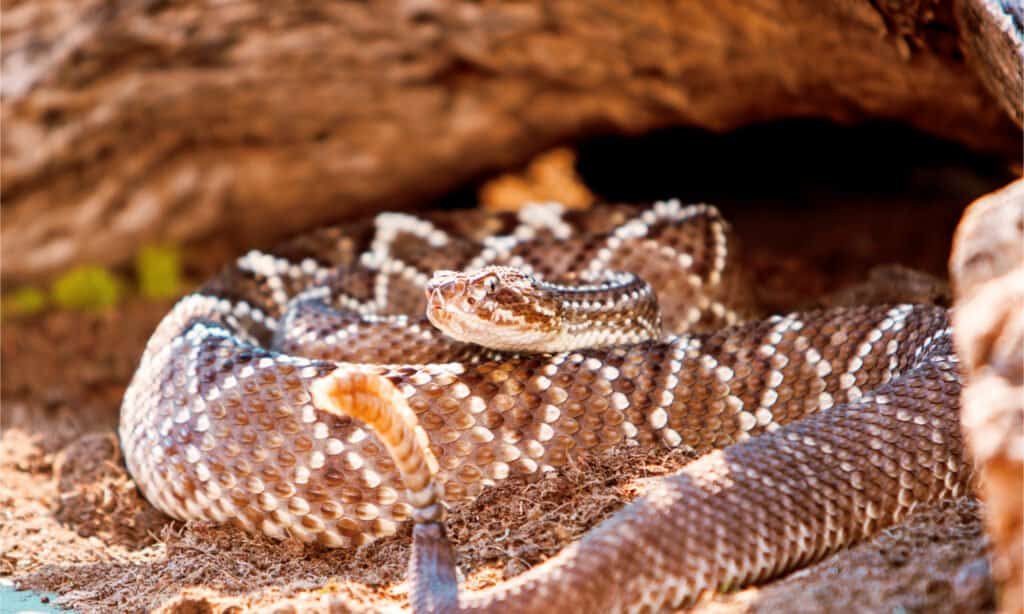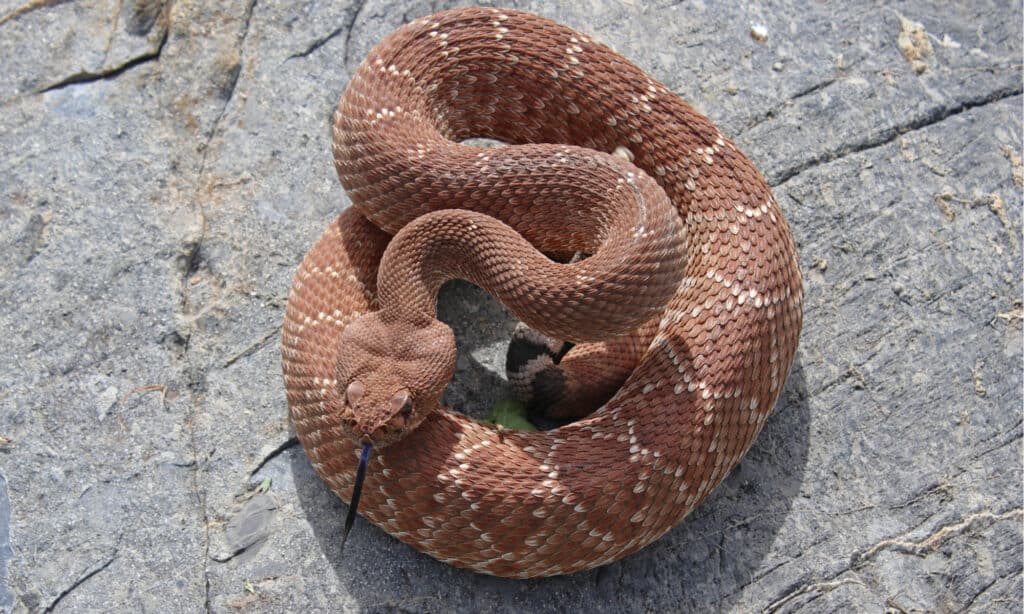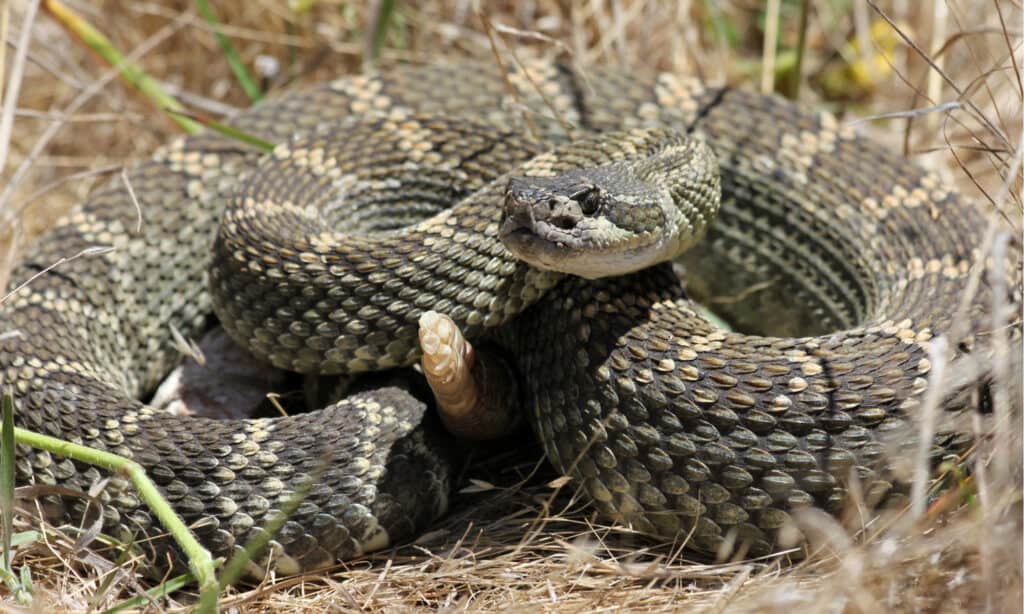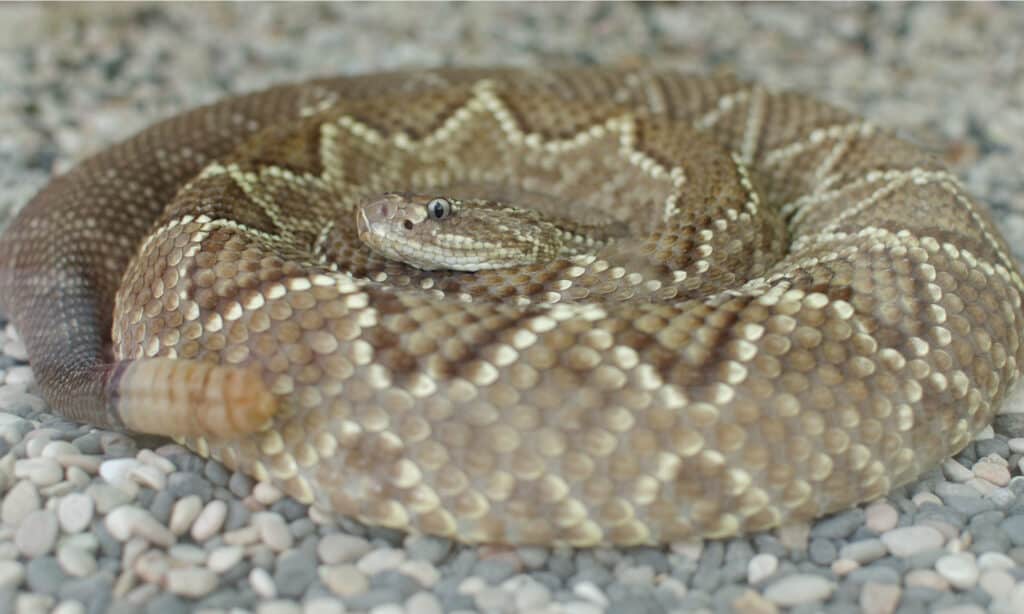The snake world is more diverse than most people realize. Rattlesnakes are proof. With approximately 56 rattlesnake species and over a dozen subspecies, the rattlesnakes are fascinating. Some have relatively mild venom, while others can kill a human with the tiniest amount.
Yet, have you ever wondered how big they get?
Curious yet? Let’s explore!
How Big Do Rattlesnakes Get?
As with other snake genera like pythons, there’s a tremendous range of sizes. These venomous snakes vary in size from the very small pygmy and midget faded rattlesnakes to the truly huge eastern diamondback rattlesnake.
On average, rattlesnakes usually wind up between three and five feet long, depending on the species. Snakes that live further in cooler climates are typically smaller because the resources are leaner, and the time they can spend active during the year is shorter.
The limited time rattlesnakes have for activity affects everything: feeding, growing, and breeding. Unlike mammals, snakes can’t eat if the weather isn’t warm enough because their bodies depend on external temperatures. Technically speaking, they can eat, but if it’s too cold, the meal will rot in their stomach because snakes cannot produce body heat the way mammals can.
That’s why we call them ectotherms — cold-blooded. They need the sun to warm their bodies.
Because they don’t eat when it’s too cold, they also can’t grow because, just like us, they need fuel to grow.
Eastern Diamondback Rattlesnake (Crotalus adamanteus)
Eastern diamondback rattlesnakes prefer pine flatwoods, pinewood flats, palmetto pinewoods, and other drier areas with enough cover. They overwinter in gopher tortoise burrows and similar underground hideouts. This species lives in the eastern United States, from Louisiana to the Eastern Seaboard as far north as North Carolina.
Fortunately, although their venom is dangerous and they can inject a massive quantity, eastern diamondback rattlesnakes are pretty mild-mannered and calm.
Among the most feared rattlesnakes, eastern diamondbacks are also one of the biggest. These rattlers can reach over seven feet long, and many experts say they can reach eight feet at their longest. One of the largest ever caught was in 2009 and measured almost seven and a half feet long from snout to base of the rattle. To get a better idea of that scale, imagine a typical four-foot-long park bench and place two of them side-by-side. That’s how long these snakes can get!

Eastern diamondback rattlesnakes’ pattern often fades towards their tail.
©Chase D’animulls/Shutterstock.com
Western Diamondback Rattlesnake (Crotalus atrox)
This snake is notorious because of its rather unpleasant personality. Where most rattlesnakes want to be left alone and are happy to leave you alone, western diamondback rattlesnakes are different. These nervous, reactive snakes are terrified of everything bigger — including you!
Snakes occupy a unique place in the food chain. They’re both predators and prey to many other animals. As a result, some species have developed some interesting defensive tactics. In the western diamondbacks’ case, they’re more likely to bite, not because they’re mean, but because they’re on the menu of nearly every predator bigger than them. Even roadrunners. So, they try to bluff their way out of every perceived jam.
Western diamondback rattlesnakes are big, heavy-bodied rattlesnakes that can pack a nasty bite. Their venom, delivered by two one-inch-plus fangs, damages tissue and blood cells. These snakes don’t always envenomate, but it requires medical attention when they do. One of the bigger species, these species average about four feet long, and five and six-footers are rare but not impossible.
According to Klauber in “Rattlesnakes: Their Habitats, Life Histories, and Influence on Mankind,” the longest western diamondback rattlesnakes can reliably grow is seven feet — as tall as many NBA players!

Western diamondback rattlesnakes coil up and rattle their tails to discourage predators.
©Audrey Snider-Bell/Shutterstock.com
Timber Rattlesnake (Crotalus horridus)
This snake, featured on the Gadsden Flag, was once common throughout most of its range. Timber rattlesnakes are big but not jumpy. They’re pretty relaxed pit vipers, and bites are rare, thanks to their calm disposition.
A timber rattlesnake’s pattern is distinctive and consists of V or M-shaped markings over a lighter base color. Some have an orange or reddish dorsal stripe between the dorsal markings and a black tail ending in a large rattle. Most adults average less than 45 inches long and about five pounds, but according to some records (Klauber, 1956), the maximum reported length for these snakes is six feet, two and a half inches. That’s a little longer than a standard six-foot dog leash.

Be careful around Timber Rattlesnakes that are highly venomous.
©Frode Jacobsen/Shutterstock.com
Neotropical Rattlesnake (Crotalus durissus ssp.)
This rattler, also called the South American rattlesnake, is a large rattler present in many areas of the continent. Including the nominate subspecies, there are seven subspecies, all native to different countries.
While they’re not terribly grumpy, like western diamondback rattlesnakes, a bite from one of these can do some damage. Fast.
Unlike most of their central and North American cousins, neotropical rattlesnakes have high percentages of neurotoxins in their venom. These toxins have startling effects, including blindness and auditory disorders. However, paralysis of peripheral muscles (around the neck!) that also occurs can make the muscles so floppy that a person’s neck can look broken!
At their very largest, neotropical rattlesnakes will grow a little over six feet (6.2) long, about as long as your average living room couch. However, they do not weigh as much as eastern diamondback rattlesnakes and probably max out at around five pounds.

South American rattlesnakes can grow up to 6 feet long; they rarely get a little longer.
©GoodFocused/Shutterstock.com
Red Diamond Rattlesnake (Crotalus ruber)
Native to extreme southern California through Baja California and a few islands in the Gulf of Mexico, red diamond rattlesnakes have a fairly calm demeanor. Although they’re calm, don’t mistake calm for harmless. These rattlesnakes’ large size makes them capable of a nasty bite — even with the milder venom they possess.
Red diamond rattlesnakes have black and white tail bands and a well-developed rattle. Their dorsal diamond markings aren’t as pronounced as other species but are present and outlined in white. As they age, their markings become darker and harder to see, but they keep the reddish color throughout their lives.
These are big rattlers, and the biggest on record was five feet, two inches long from snout to tail, about the same length as the short side of a queen-sized bed.

Red diamondback rattlesnakes coil up, rattle, and may strike when threatened.
©Creeping Things/Shutterstock.com
Northern Pacific Rattlesnake (Crotalus oreganus)
This rattler is native to areas from California north to southern Canada. Northern Pacific rattlesnakes are common throughout their range and have white-edged dark brown dorsal blotches over a brown, gray, yellowish, or sometimes nearly black base color. Their tail bands are dark and light colored that often match the body colors, ending in a pretty loud rattle.
Far from being the largest of rattlesnakes, northern Pacific rattlesnakes still reach respectable lengths! They average around four feet long, but they can get up to five feet, four inches long — or about as long as the short side of a queen-sized bed.

Northern Pacific rattlesnakes are food for almost anything bigger.
©Ryan M. Bolton/Shutterstock.com
Central American Rattlesnake (Crotalus simus)
Native to central America in southern Mexico, Guatemala, Honduras, El Salvador, Costa Rica, and Nicaragua, this rattlesnake lives in dry tropical forests, thorn woodland, and dry scrub forests.
They’re gorgeous snakes with bold diamond-shaped saddle markings outlined in white. Like the others in the C. durissus group (called a complex), they have stripes that start at the neck and extend several inches down the back.
Central American rattlesnakes have keeled scales, but they’re raised even further than rattlesnakes in the U.S., giving an almost dragon-like feel to the snake’s scales.
This is a big snake, often exceeding 51 inches, and the maximum is 71 inches — about as long as a standard couch. Weight-wise, information is a little sparse, but a best guess is somewhere around five to ten pounds.

Central American rattlesnakes are huge, ranging from 51 – 71 inches.
©edography/Shutterstock.com
The Largest Rattlesnake Ever Caught: Eastern Diamondback Rattlesnake
As mentioned, this species is among the biggest rattlesnakes. We didn’t say that the biggest rattlesnake on record was an eastern diamondback rattlesnake caught by someone named Rutledge. These are some of the heaviest venomous snakes in the world, along with the Gaboon viper.
Eastern diamondback rattlesnakes embody what you expect when you think of a “heavy-bodied rattlesnake.” They’re stocky and powerful with a bold diamond pattern down their body that fades closer to the often black tail before an often large rattle.
According to the Guinness Book of World Records, the largest rattlesnake ever was an eastern diamondback rattler. This monster of a venomous snake was caught in 1946 and measured seven feet, nine inches long from its snout to the base of its rattle, and weighed 34 pounds!
That snake was longer than most NBA players are tall and nine inches bigger than a doorway.
Places You’re Most Likely to Encounter Eastern Diamondback Rattlesnakes
If rattlesnakes longer than NBA players are tall terrify you, then you’ll be happy to know they only live in the eastern United States. They live in various habitats, from palmetto flats to wooded areas from far eastern Louisiana to the Atlantic Ocean and the southern portions of every state in between, as far north as southern North Carolina and all of Florida.
Eastern diamondback rattlesnakes are big but not so bad — unless you’re bitten. Their size makes them formidable and capable of injecting dangerous quantities of venom. Fortunately, they aren’t aggressive snakes; if you give them time and space, they’ll move along.
They’re most active from April to October, but snakes in southern Florida may not brumate for the winter. If they do brumate, it may not be for long. Those further north brumate, often using gopher tortoise burrows for shelter.
| Snake | Location | Size |
|---|---|---|
| Eastern Diamondback Rattlesnake | Eastern United States, from Louisiana to North Carolina, south to Florida | Possibly 8 feet long, or the equivalent of two park benches. |
| Timber Rattlesnake | Eastern U.S. | About seven feet long — the same as an average NBA player’s height |
| Neotropical Rattlesnake | Various countries throughout South America | About six feet, or about the same as a standard dog leash |
| Red Diamond Rattlesnake | Southern California and Baja California | Just a hair over six feet long, just longer than a standard dog leash |
| Northern Pacific Rattlesnake | Central California north to southern Canada | About five feet long, about the same as the short side of a queen sized mattress. |
| Central American Rattlesnake | Southern Mexico south to Costa Rica | Six feet long, the same as a Standard couch or dog leash |
The photo featured at the top of this post is © Kristian Bell/Shutterstock.com
Discover the "Monster" Snake 5X Bigger than an Anaconda
Every day A-Z Animals sends out some of the most incredible facts in the world from our free newsletter. Want to discover the 10 most beautiful snakes in the world, a "snake island" where you're never more than 3 feet from danger, or a "monster" snake 5X larger than an anaconda? Then sign up right now and you'll start receiving our daily newsletter absolutely free.
Thank you for reading! Have some feedback for us? Contact the AZ Animals editorial team.






